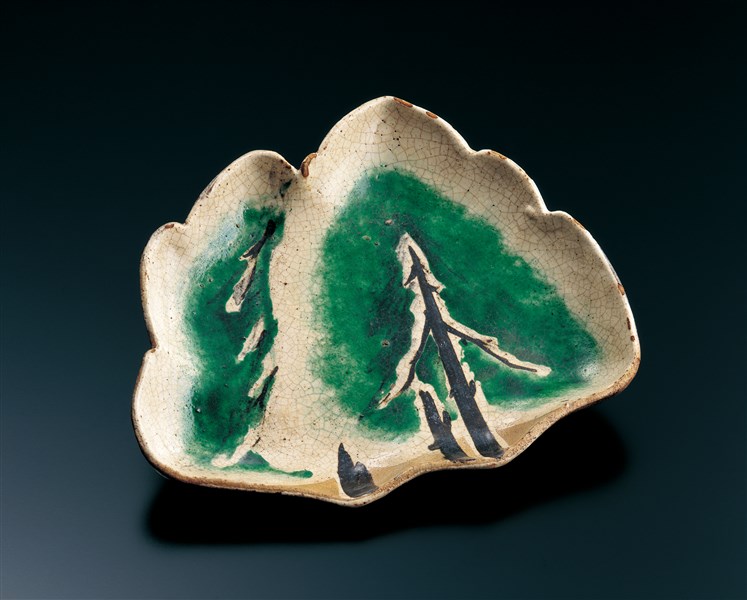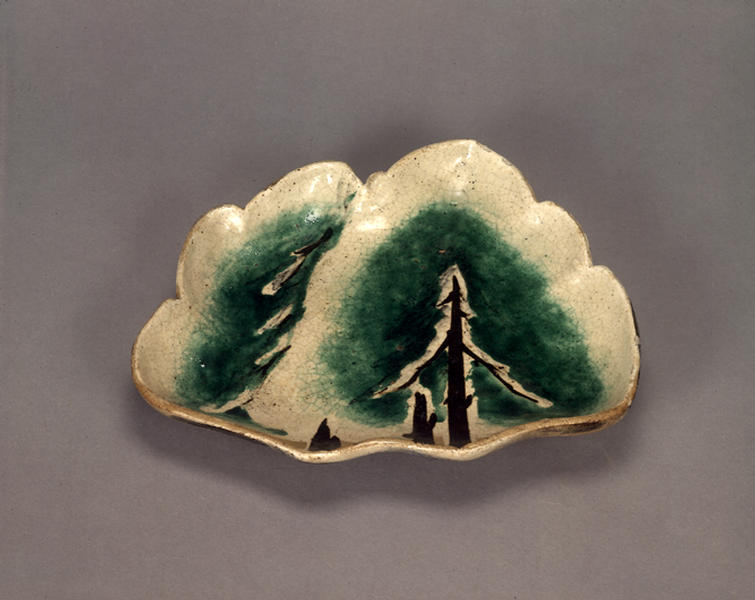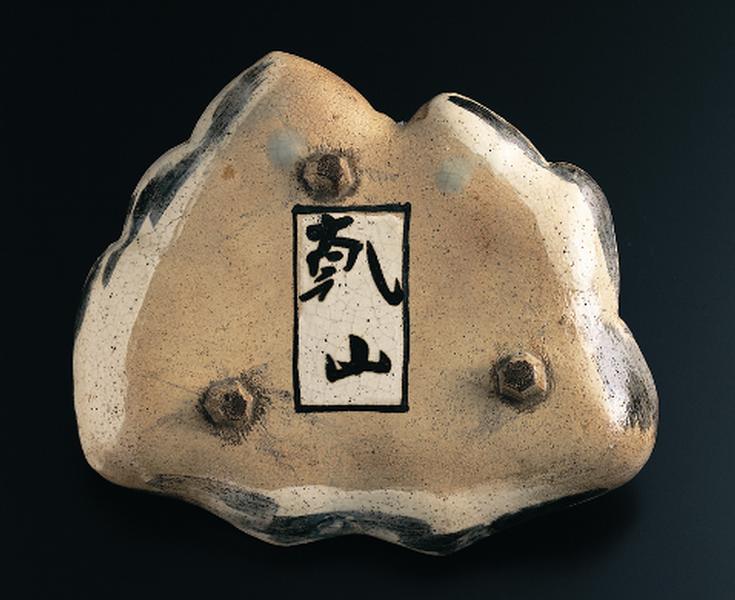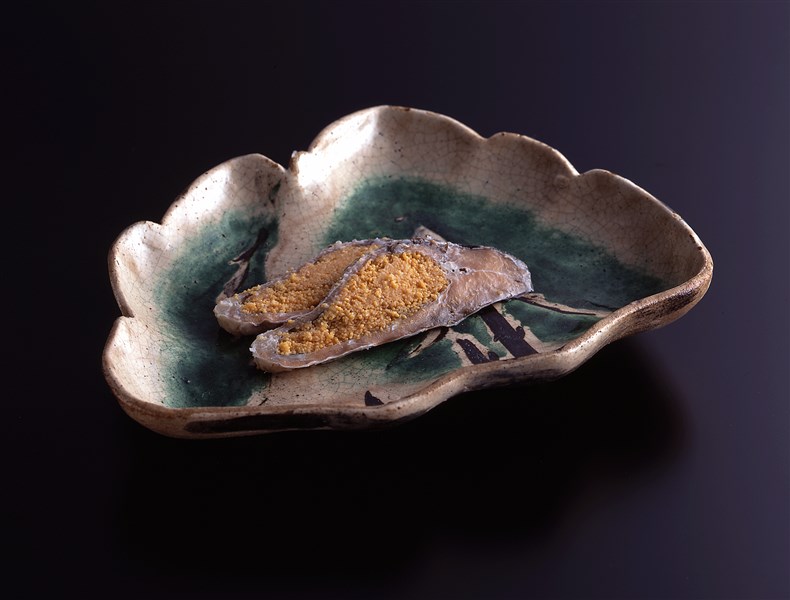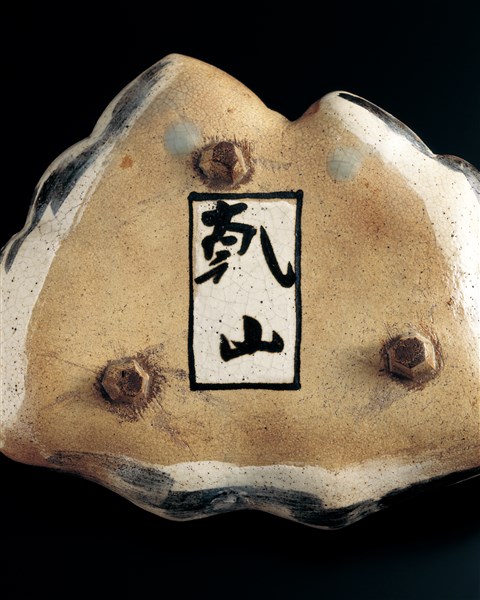乾山色絵雪杉図向付
- 江戸時代
- 18世紀
雪にまつわる図柄は松だけではなく、杉もある。本作は二本の重なり合う杉が雪を被った図柄で、これもその姿がそのまま器形となっている。型造りで成形され、白化粧の下地を施して銹絵で杉の枝幹を描く。裏面側面にも白化粧下地が施され、銹絵で刷毛引きされる。全体に透明釉を掛けて本焼した後、杉葉の部分に緑の上絵付が施され、幹の根元、土坡の部分には一見してわかりにくいが、金彩が施されている。裏面には六ないし七角錐形の脚が三つつき、脚底部のみ露胎、脚を削った痕跡がよく残っている。中央に、短冊形の白化粧下地に銹絵で縁取された「乾山」銘が記される。透明釉には全体に細かい貫入が、白化粧の部分にはいくつもピンホールが生じ、柔らかい釉調の肌合いとなっている。また底部には灰青色を呈する灰釉系透明釉のトンボの目状の釉溜が美しく生じている。雪松図平鉢(作品136・137)も同様であるが、冠雪を表すため口縁には銹絵の口紅は施されていない。本来は組物であったと思われるが、今のところ他に作例は見られない。成形法や乾山銘の施し方など、典型的な二条丁子屋町時代の作風を示する向付である。
尾形乾山
尾形乾山(おがたけんざん 1663~1743)
乾山は、寛文3年(1663)京都の富裕な呉服商尾形宗謙(おがたそうけん)の三男として生まれました。兄は画家の光琳です。二人の性格は対象的で、光琳が派手好みであったのに対し乾山は内省的、隠遁的な性格の持主であったといわれています。
野々村仁清に陶芸を学んだ乾山は、元禄12年(1699)37歳のとき京都市の鳴滝に開窯しました。そして正徳2年(1712)50歳の乾山は、京市内の二条丁子屋町に移住し、多くの作品を手がけ「乾山焼」として世にもてはやされました。鳴滝時代の末期からこの丁子屋町時代にかけて兄の光琳は絵付で乾山を助け、兄弟合作の作品が数多く残されています。
享保16年(1731)69歳の頃に江戸に下り寛永寺(かんえいじ)領入谷(いりや)に窯を築いて晩年を送りました。そして81歳で没するまで江戸に在住し陶器や絵画の制作に手腕を発揮しました。
乾山の作品は陶芸作品のみならず書や絵画においても、俗気を脱したおおらかで文人的な洒脱味があります。陶芸作品においては成形、施釉、焼成は他の専門的な陶工に任せたり、絵付についても光琳との合作以外に複数の専門画家が携わっていたと思われるなど、基本的には工房生産という態勢をとっていたようです。しかし、乾山の指導のもとにつくられたやきものには、その大胆なデザイン感覚とともに乾山特有の芸術性が溢れ、乾山その人とふれあうような親しみが感じられるのです。
乾山銹絵染付掻落絵替汁次
乾山銹絵染付梅波文蓋物
乾山立鶴図黒茶碗
乾山銹絵染付桔梗図筒向付
乾山銹絵染付草文四方鉢
乾山銹絵染付松図茶碗
乾山色絵短冊皿
乾山銹絵絵替長平皿
乾山色絵寿字輪花向付
乾山銹絵絵替四方皿
乾山銹絵染付絵替筒向付
乾山銹絵染付松図茶碗
乾山色絵椿文向付
乾山銹絵染付春草図茶碗
乾山銹絵染付藤図向付
乾山色絵立葵図向付
乾山色絵桔梗文盃台
乾山銹絵馬図香合
乾山銹絵染付絵替扇形向付
乾山銹絵掻落雲唐草文大鉢
乾山銹絵草花波文水指
乾山銹絵染付絵替土器皿
乾山色絵槍梅図茶碗
乾山黒楽梅図茶碗
乾山銹絵染付芙蓉図茶碗
銹絵掻落牡丹唐草文香合
撫子図(尾形乾山筆)
乾山色絵和歌陶板
乾山色絵竜田川図向付
乾山銹絵牡丹画角皿 尾形光琳画
乾山銹絵百合形向付
乾山銹絵松文香合
乾山色絵阿蘭陀写市松文猪口
乾山色絵薄図蓋茶碗
乾山銹絵菊図水指
鶴亀図黒茶碗
紅葉図 尾形乾山筆
三十六歌仙絵/在原業平像 尾形乾山筆
三十六歌仙絵/斎宮女御像 尾形乾山筆
乾山色絵菊文手付汁次
三十六歌仙絵/小野小町像 尾形乾山筆
乾山銹絵染付山水図茶碗
Catalogue Entry
Snow-covered tree designs in Japan can depict either pine trees or sugi cryptomeria trees. This work depicts two cryptomeria trees blanketed in snow, with the outline of the dish following the shape of the trees. Mold-formed, the dish was coated in white slip, and then underglaze iron was used to draw the trunks of the trees. The exterior side surfaces were also coated in white slip and decorated with underglaze iron broad-brush strokes. The dish was coated with transparent glaze overall and fired at a high temperature. After this main firing, green overglaze enamel was used to depict the cryptomeria foliage area, and gold pigment was brushed around the base of the trunks to depict the ground. The gold pigment has since flaked off. The back surface has three hexagonal or septagonal-shaped attached conical feet, and the base edge of each foot was left unglazed. The marks of the carving tools remain clearly visible on each foot. In the center of the dish back, a “Kenzan” signature drawn in underglaze iron is placed in a white slip tanzaku poem paper-shaped frame that is bordered with a single line of underglaze iron. Fine crackling has formed in the glaze overall and there are several pinholes in the white slip areas, giving the dish a softened surface feel. There are pale ash blue colored spots of puddled transparent glaze on the back surface that formed beautifully in the firing. As in the snow-covered pine tree design dishes shown here as cat. nos. 136 and 137, the underglaze iron usually brushed around the mouth rim edge of this type of dish has been omitted here, leaving the mouth rim light and furthering the sense of complete snowy coverage. While this work is thought originally to have been part of a set, it is the only known extant dish of its type. The formation techniques seen and the “Kenzan” signature handling are all typical of a mukozuke dish made during the Nijochojiyacho period.
色絵雪杉図向付 美し 乾山 図録解説
色絵雪杉図向付 美し 乾山 四季彩菜 図録解説
雪にまつわる図柄は松だけではなく杉もあるぞと、この向付はそう主張しているように思えます。雪を被った幾本かの杉が重なり合う構図で、これもその姿がそのまま器の形となっています。
型造り成形、白化粧の下地を施して銹絵で杉の枝幹を描き、裏面の側の一部にも白化粧下地を施して銹絵で刷毛引きされています。全体に透明釉を掛けて本焼した後、杉葉の部分に緑の色絵が上絵付けが施されています。一見して判り難いですが、よく見ると幹の根元、土坡の部分には金彩が施されています。
裏面には、六ないし七角錐形の脚が三つ付き、畳付のみ土見せ、中央に短冊形の白化粧下地に銹絵で縁取りされた乾山銘が記されています。透明釉には全体に細かい貫入が、白化粧の部分にはいくつもピンホールが生じ、柔らかい釉調の肌合いは何ともいえない味わいがあり、また底に生じた、美しい灰青色をした灰釉系透明釉のトンボの目状の釉溜りも見どころのひとつといえるでしょう。冠雪を表すため、乾山お得意の口縁の銹絵口紅は施されていません。これもよく考えられた意匠といえます。
本来は組物であったものと思われますが、今のところ他に作例は見られません。成形法や乾山銘の施し方など、典型的な二条丁子屋町時代の作風を示す向付と位置付けられます。前出の竜田川図や、菊図(東京・五島美術館、福岡市美術館蔵)、雪松図(大阪・湯木美術館、個人蔵)などとともに、この雪杉図も然(しか)り。金彩の施された乾山二条丁子屋町時代の向付群は、同じ食器の中でも一ランク上の特別な注文品であったように思えます。
Mukozuke Dish with Snowy Cryptomeria Design
Mukozuke Dish with Snowy Cryptomeria Design
This mukosuke seems to be asserting that pine trees are not the only design associated with snow - the cryptomeria (Japanese cedar) is too. Two snow-covered cryptomeria trees are overlapped in this composition, which forms the shape of the dish.
The dish was mold formed and white slip was applied as the ground for painting the trunks and branches of the trees in underglaze iron. White slip was also applied to part of the underside, with hakeme brush marks brushed into it. A transparent glaze was applied to the entire piece. After the glaze firing, green overglaze enamel was applied to depict the cedar foliage. While somewhat difficult to distinguish at first glance, gold pigment has been applied to the base of the trunk and the earth below it.
The underside has three six or seven-sided pyramidal feet attached. Only their bottom edge is unglazed, revealing the clay. The Kenzan signature is inscribed on a rectangular poem slip form on a ground of white slip, outlined in underglaze iron. The transparent glaze has fine crackles throughout, and some pinholes have developed in the slip. The texture of the delicate glaze is remarkable, while the pooling of the beautiful gray-green translucent ash glaze on the base is also one of the highlights of this piece. To highlight the snow on the pines, the iron pigment rim that was one of Kenzan's fortes is omitted. Careful thought went into this design.
This mukosuke was probably part of a set, but no other examples are now known. Given the forming method and the way the Kenzan signature was applied, we can position this piece as indicating the classic Nijo Chojiyamachi period style. This snowy cryptomeria motif is similar to the Tatsutagawa motif of the previous piece, the chrysanthemum motif (Gotoh Museum, Tokyo; Fukuoka Art Museum collection), and the snowy pine motif (Yuki Museum of Art, Osaka; private collection). Kenzan's mukozuke with gold pigment from his Nijo Chojiyamachi period are thought to have been created as special orders and thus are a rank above other pieces from that period.
